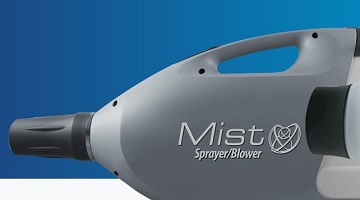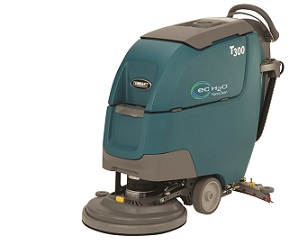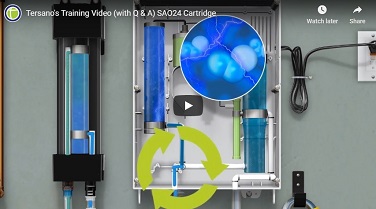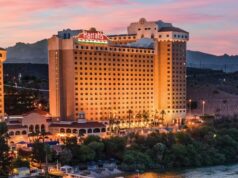
NATIONAL REPORT—With so much attention on virus elimination given the COVID-19 pandemic, Green Lodging News has been exploring green cleaning technologies that make it easier for hoteliers to provide a safe, hygienic, disinfected environment for guests and employees. One such technology is electrochemical activation (ECA)—the process for creating electrolyzed water using a low electric charge and natural minerals. Hypochlorous acid, one of the sanitizers created from charged salt and water, has 80 to 200 times the sanitizing power of chlorine bleach, according to Larry Smith, Vice President of Sales for GenEon Technologies. In this article we will also explore stabilized aqueous ozone, the result of an electric charge being applied to tap water.
GenEon Technologies is one of several companies that sell systems that incorporate ECA. Smith says his company’s technologies fit well into the “people, planet, profit” business model. The cleaning products are safe for employees to use, generate little waste, require very little storage space, and offer a reasonable return on investment—in one year for a 150-room hotel that uses the GenEon InstaFlow system that produces 40 gallons of cleaning products in one hour.
Zero-VOC GenEon systems can produce three types of cleaners: glass and general purpose, heavy duty all-purpose cleaner, and sanitizer/disinfectant. “Hypochlorous acid kills viruses, period,” Smith says. He says the Georgia National Guard is currently using GenEon systems to treat several hundred nursing homes. GenEon systems are also used in schools and hotels. “There is no industry that could not use our product,” Smith says.
Smith says customers who typically purchase the InstaFlow system also purchase a portable misting system. “The mist kills the bacteria in the air and on the surfaces. It reaches hard to reach areas. You don’t have to wipe it down afterward,” he says, adding that the systems his company sells help eliminate the containers and spray bottles typically found in storage rooms or on housekeeper carts.
Dwell time, the amount of time a cleaning fluid is supposed to sit on a surface before being wiped, can typically be 10 minutes but Smith says electrolyzed water needs only about 30 seconds.
Smith says COVID-19 is going to change the way people think about cleaning, and the way they think about the folks who do the cleaning. “Cleaners perform a great service and do save lives,” he says.
Electrolyzed Water & Floor Cleaning
Another company that uses electrically converted water for cleaning is Tennant Co. The company’s ec-H2O NanoClean technology electrically converts water into a cleaning solution with microscopic nanobubbles. Tennant’s ec-H2O NanoClean technology is used in its own floor cleaning machines and leaves no chemical residue. It reduces the costs associated with conventional floor cleaning detergents, like purchasing and inventory management. Plus, there are productivity gains when operators require less training and don’t waste time mixing chemicals. Additionally, scrubbers equipped with ec-H2O technology use less water so they can scrub up to three times longer between non-productive dump and fill cycles.

By creating cleaning fluid on-site, one dramatically reduces the environmental impact of floor cleaning. A lot of energy and water is spent getting more traditional cleaning chemicals to market. Reid Rabon, Senior Product Manager, Robotics & Water Technologies for Tennant, says his company’s cleaning solution has no fragrances and is not harmful to cleaning personnel. Oftentimes, toxic cleaning chemicals cause skin reactions or chemical sensitivities.
“It is a water electrolyzer technology that uses minerals in water to create a replacement for detergent products,” Rabon says. “You just fill up the machine with water. The electrolyzing is done in the machine. The electrolyzed water and dirt is recovered by the machine’s squeegee. We have a lifecycle assessment that shows all the different benefits.”
According to a third-party study by EcoForm, ec-H2O NanoClean technology significantly impacts green cleaning operations in seven key categories: energy, CO2 emissions, ozone, smog, acid, eutrophication, and particulates. In some cases, these can be reduced by up to 97 percent.
Rabon emphasizes that Tennant’s machines do not disinfect but are an important part of the disinfection process. An auto scrubber provides a high degree of mechanical action using a pad or brush. “Cleaning is required prior to disinfecting,” Rabon says. “It is an important pre-step if you want to disinfect.”
Rabon says Tennant machines most commonly used in hospitality are micro-scrubbers including the T1 and i-mop as well as the smaller T2 & T300 walk-behind scrubbers.
Stablilized Aqueous Ozone
Tersano applies electricity to tap water to create stabilized aqueous ozone (SAO). According to the company, SAO eliminates germs, odors, stains, mold and mildew. SAO kills viruses and bacteria, contains no toxins, leaves no chemical residue, and converts safely back to tap water and oxygen. In a letter posted on the company’s website, the company’s president, Steve Hengsperger, says SAO has not been officially tested against the COVID-19 Coronavirus, but SAO kills viruses like COVID-19 quickly and easily.

SAO can be dispensed to spray bottles for large-scale use or by using Tersano’s iClean mini. A cartridge adjusts the minerals in the water first, stabilizing the tap water so that regardless of where in the world tap water originates from, it is consistent and maximized for cleaning and sanitizing performance. Without the cartridge, regular aqueous ozone only delivers 15 minutes of sanitizing. After passing through the SAO-4 cartridge, stabilized aqueous ozone remains potent for up to four hours of sanitizing time and three days of cleaning time. Using the SOA-24 cartridge, SAO will last up to 24 hours as a sanitizer and six days as a cleaner.
PathoCide & PathoClean
As with GenEon Technologies, PathoSans allows the users of its systems to create their own cleaning solutions on-site. PathoSans electrolyzed water technology converts softened water and salt into two distinctly different electrolyzed water solutions. The first is hypochlorous acid. The company calls it PathoCide. It has been proven to meaningfully reduce the presence of many dangerous pathogens like MRSA and E. coli. PathoCide has also demonstrated efficacy against human coronavirus and other viruses more resilient to disinfection such as Bovine Viral Diarrhea virus (Hepatitis C surrogate), Influenza A virus, and Herpes simplex virus type 2.
The second solution is a highly activated, dilute solution of sodium hydroxide and can be used as an effective detergent and grease cutter. It is called PathoClean. At less than 400 parts per million of sodium hydroxide (NaOH), PathoClean successfully replaces caustic chemicals containing over 4,000 parts per million of NaOH. PathoClean can be used for surface cleaning and biofilm removal, the first step of effective cleaning.
Also be sure to check out Viking Pure Solutions.
Glenn Hasek can be reached at greenlodgingnews@gmail.com.







